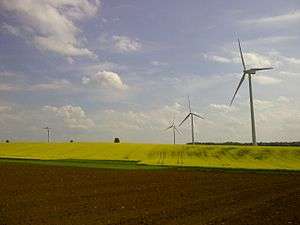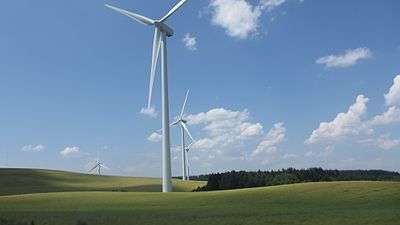Wind power in France
In 2017 France reached a total of 13,759 MW installed wind power capacity[1] placing France at that time as the world's eighth largest wind power nation by installed capacity, behind the United Kingdom and Canada and ahead of Italy and Brazil. According to the IEA the yearly wind production was 20.2 TWh in 2015, representing almost 23% of the 88.4 TWh from renewable sources in France during that year.[2] Furthermore wind provided for 4.3% of the country’s electricity demand out of the 18.7% provided by renewables in 2015.[2]

France has the second largest wind potential in Europe.[3] The country's large wind power potential is due to its large land area and extensive agricultural landscape where turbines may be located more readily as well as access to considerable offshore resources.
Timeline of developments
2016
While France has been a relative late developer in wind power compared to other European countries it has set the target of more than doubling onshore wind power capacity from 2015 levels by 2023.[2] Offshore wind power is scheduled to come online from 2018 for the first time and including marine energy could rise to up to 11.1 GW of power by 2023.[2] Realisation of these plans would more than likely see France overtake highly ranked Spain in terms of installed capacity by 2023.
2015
As of year end 2015 all windpower in France was onshore, the first 500 MW of offshore windpower is not due to come online until 2018. By year end 2015 the total onshore installed capacity of 10,358 MW consisted of 5,956 turbines, making the average turbine at just under 2 MW of power, newer turbines may be larger following the development of wind power in the last decades.[1] The leading regions in France in 2015 were Champagne-Ardenne with an installed capacity of 1,682 MW, Picardie with 1,502 MW, Centre with 872 MW and Bretagne with 836 MW.[1]
2006
Installed capacity rises above 1 GW for the first time during the year, it is to be another 9 years before the 10 GW barrier is broken.[1]
2001
The French government initially planned to produce 21% of its electricity consumption with renewable energy in 2010 to comply with European directive 2001/77/CE of 27 September 2001. This means that France had to produce 106 TWh of renewable energy in 2010 when it only produced 71 TWh in 2006. Wind power represents 75% of the 35 TWh additional production in 2010.[4]
Installed capacity

| Year | Installations (MW) | Ref. |
|---|---|---|
| 2002 | 0,148 | [5] |
| 2003 | 0,248 | [5] |
| 2004 | 0,390 | [1] |
| 2005 | 0,757 | [1] |
| 2006 | 1,711 | [1] |
| 2007 | 2,495 | [1] |
| 2008 | 3,577 | [1] |
| 2009 | 4,713 | [1] |
| 2010 | 5,977 | [1] |
| 2011 | 6,809 | [1] |
| 2012 | 7,613 | [1] |
| 2013 | 8,558 | [1] |
| 2014 | 9,285 | [1] |
| 2015 | 10,358 | [1] |
| 2016 | 12,066 | [6] |
| 2017 | 13,512 | [6] |
| 2018 | 15,108 | [6] |
| 2019 | 16,260 | [7] |
Future projections
Onshore
| 2014 | 2018 | 2023 low | 2023 high | |
|---|---|---|---|---|
| Onshore wind power | 9,300 MW | 15,000 MW | 21,800 MW | 26,000 MW |
Onshore wind power is projected to rise to 15,000 MW by 2018 and between a low target scenario of 21,800 MW and a high target scenario of 26,000 MW by 2023.[2]
Offshore
| 2014 | 2018 | 2023 | |
|---|---|---|---|
| Offshore wind power | - | 500 MW | 3,000 MW, (an additional 500 to 6,000 MW to be deployed, following consultations
in the proposed zones, the outcome and results of the first projects and on the basis of costs). |
| Marine energy (floating wind
turbines, underwater turbines etc.) |
- | - | 100 MW (an additional 200 to 2,000 MW capacity deployed,depending on the outcome of the
trial projects and according to costs) |
| Total | - | 500 MW | 3,100-11,100 MW |
The first tranche of offshore wind power is expected to come on line in 2018 with 500 MW capacity. By 2023 another traditional 3,000 MW of capacity will come online with an additional 500 to 6,000 MW of performance dependent installation planned. Marine energy including floating wind turbines will add an additional 100 MW as well as an additional 200 to 2000 MW of capacity by 2023. Overall including marine energy offshore installed capacity will rise to between 3,100 and 11,100 MW by 2023.
Offshore wind farms
See also: List of offshore windfarms in the North Sea
The following offshore windfarm projects listed have submitted their applications for consent.
| Wind farm | Cap. (MW) |
Turbines | Where | Commissioning | Build Cost |
Cap. fac. |
Depth range (m) |
km to shore |
Owner | Refs. | |
|---|---|---|---|---|---|---|---|---|---|---|---|
| Hautes Falaises (Fécamp) | 498 | 83 x 6 MW Haliade 150-6MW (GE Energy) | 49.892°N 0.227°E | 2021 onwards | €2000 million | 25-31m | 13 km | EDF (SA) | [8] | ||
| Calvados | 450 | 75 x 6 MW Haliade 150-6MW (GE Energy) | 49.470°N 0.522°W | 2018 onwards | €1800 million | 21-30m | 11 km | EDF (SA) | [9] | ||
| Banc du Guerande | 480 | 80 x 6 MW Haliade 150-6MW (GE Energy) | 47.16°N 2.607°W | 2021 onwards | €2000 million | 10-21m | 12 km | EDF (SA) | [10] | ||
| Projet eolien en Mer de la Baie de Saint-Brieuc | 496 | 62 x 8 MW AD8-180 (Adwen) | 48.854°N 2.537°W | 2020 onwards | €2500 million | 28-36m | 16.3 km | Caisses des depots et consignations | [11] | ||
| |||||||||||
Floating turbine test sites
France is operating a number of offshore test sites for prototype floating wind turbines which would allow turbines to be located in deeper waters. These include the Nenaphur test site,[12] the Nenuphar twin float,[13] the Floatgen Project[14] and the Sem-Rev Site d'Experimentation en Mer[15] which also tests wave energy converters.
See also
- Renewable energy in France
- Solar power in France
- WPO (Company)
- Renewable energy by country
- Wind power in the European Union
References
- "Statista, Wind power in France".
- "Ministre de l'Environnement, de l'Énergie et de la Mer, Programmation pluriannuelle de l'énergie, 27 October 2016".
- "Wind Energy the Facts".
- source: Jérôme Gosset et Thierry Ranchin: Bilan et prospective de la filière éolienne française)
- http://www.thewindpower.net/country_en_1_france.php
- https://www.statista.com/statistics/421684/wind-power-capacity-in-france/
- https://www.statista.com/statistics/1074682/capacity-production-energy-wind-france/
- http://www.4coffshore.com/windfarms/parc-%C3%A9olien-en-mer-de-f%C3%A9camp-france-fr34.html
- 4C . Retrieved: .
- 4C . Retrieved: .
- 4C . Retrieved: .
- "France Energies Marines".
- "INFLOW".
- "Floatgen".
- "Marine Test Site".